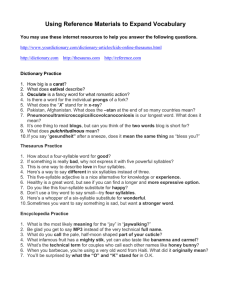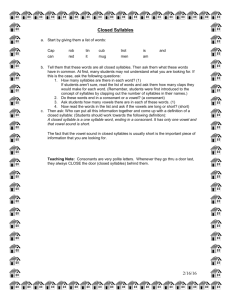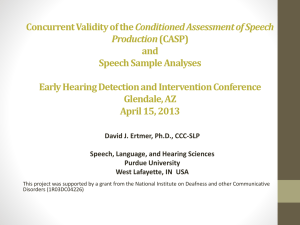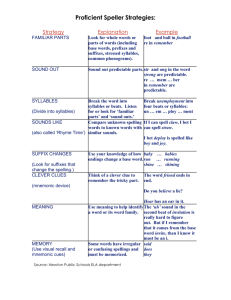2. Basic Canonical Syllables - National Center for Hearing
advertisement
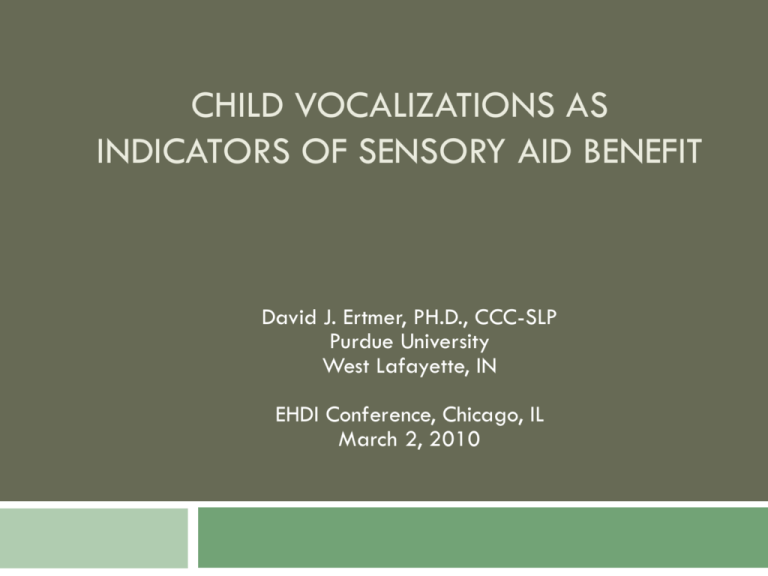
CHILD VOCALIZATIONS AS INDICATORS OF SENSORY AID BENEFIT David J. Ertmer, PH.D., CCC-SLP Purdue University West Lafayette, IN EHDI Conference, Chicago, IL March 2, 2010 Vocal Development is… a process by which infants and toddlers produce increasingly complex, phonetically diverse, and speechlike vocalizations prior to saying words on a regular basis. Three-Category System Adapted from the Stark Assessment of Early Vocal Development-Revised (SAEVD-R; Nathani, Ertmer, & Stark, 2006) Simplified classification of vocalizations 1. Precanonical (SAEVD-R levels 1 – 3) 2. Basic Canonical Syllables (SAEVD-R level 4) 3. Advanced Forms (SAEVD-R level 5) Precanonical Vocalizations… (Range of emergence 0 – 6 months in NH children) …lack true vowels and true consonants in combination with a rapid transition between them (Oller, 2000) Types Quasi- and fully-resonant nuclei (Oller & Lynch, 1992) Squeals Vowels / vocants in isolation or in series (Kent & Bauer, 1985) Consonants / Closants in isolation or in series (Stark, 1980) Basic Canonical Syllables (Range of emergence 6 – 10 months in TD children) characterized by… Normal phonation (voicing) Full vocalic resonance (a vowel) At least one consonant Rapid CV transitions (Oller & Lynch, 1992) Types CV syllables and disyllables (CVCV) Reduplicated and nonreduplicated babbling Whispered vocalizations Oller, D. K. & Eilers, R. E. (1988). The role of audition in infant babbling. Child Development 59, 441 -449. Advanced Forms (Range of emergence in NH children: 10 - 18 months) … have canonical attributes but are phonetically or prosodically more complex than BCS (Nathani, Ertmer, & Stark, 2002) Types Complex syllables (e.g. CCV or CVC) Jargon combinations of different consonants and vowels with changes in stress or intonation Diphthongs Cross-sectional Data: 30 Infants with NH Nathani, Ertmer, & Stark (2006) Typically Developing Infants 100 80 Precanonicals 60 AF 40 20 0 0 - 2 Mos. BCS 3-5 Mos. 6 - 8 Mos. 9 - 12 Mos. 13 - 15 Mos. 16 - 20 Mos. http://www.vocaldevelopment.com Definitions More audio and examples of PC, BCS, and AF vocalizations Video examples of language input and response strategies Prelinguistic Intervention program (SPPI) More Video Examples Precanonicals http://www.youtube.com/watch?v=RoXgiqR9gAU http://www.youtube.com/watch?v=os0DQ7mXeg8&featur e=related Basic Canonical Syllables http://www.youtube.com/watch?v=JMRs5m2k9As&feature =related http://www.youtube.com/watch?v=r77hfsFprCo Advanced Forms http://www.youtube.com/watch?v=PzebHoSuxO4 http://www.youtube.com/watch?v=hiaYZ-jdb3w Profiles of Vocal Development in Young Cochlear Implant Recipients Ertmer, D. J., Young, N. M., & Nathani, S. (2007) This project was supported by a grant from the National Institute on Deafness and other Communicative Disorders (1R03DC04226) awarded to the first author. Contributors: Data collection: Kristin Corbett, Kathy Saindon, Jennifer Mellon, and Mary Nallenweg Data management and analysis: Claire Johnson, Lynnette Strong, Lisa Lachowicz, Christine Miller, and Jennifer Quesenberry “Profiles” Participants 3 male and 5 female children Implanted by 36 mos. Reported to be typically developing From English-speaking families Half of families used signs before implantation All received in-home intervention and were enrolled in oral education programs after 3 years of age Data Collection • Half-hour parent-child play sessions recorded – – Twice pre-implantation Monthly after activation until vocal development completed: • • • BCS and AF levels are established (> 20%) Precanonicals are produced less frequently than either BCS or AF 50 utterances analyzed per session Time-course for Completion of Vocal Development M3 Age at Implantation F5 F4 Months until Vocal Development Complete F3 F2 M1 0 10 20 30 Chronological Age (Mos.) 40 50 Vocal Development during the First Year of CI Use: Comparisons with Typically Developing Infants Ertmer & Jung, manuscript in preparation Acknowledgements: Project funded by a grant from the National Institute of Deafness and other Communicative Disorders (R01DC007863). Data Collection conducted at ChildsVoice school, Wood Dale, IL; St. Joseph Institute (St. Louis, MO and Indianapolis, IN); The Moog Center, St. Louis, MO; and Ohio Valley Voices, Cincinnati, OH. Data Analysis: Jen Slanker, Christie Macak, A.J. Olsciewski, Katie, Connell, and Elesha Sharp. Methods Participants: 13 children with CIs (Mean age at implant = xx months) 11 Typically developing infants Data Collection: 20-minute parent/EI-child play interactions CI – 3, 6 9, and 12 months post-activation TD – 6, 9, and 12 months of age Data Analysis: Child vocalizations classified as Precanonical (PC) Basic Canonical Syllables (BCS) Advanced Forms (AF) Precanonical Vocalizations Precanonical Percent of Utterances 100 80 60 CI PC TD PC 40 20 0 3 6 9 Months 12 Basic Canonical Syllables 100 Percent of Utterances 80 60 CI BCS TD BCS 40 20 0 3 6 9 Months 12 Advanced Forms 100 Percent of Utterances 80 60 CI AF TD AF 40 20 0 3 6 9 Months 12 Assessing Progress in Vocal Development Method 1: Spontaneous Speech Samples Method 2: Eliciting Imitations Sampling Spontaneous Speech Step 1. Classifying 50 vocalizations as Precanonical, Basic Canonical Syllables or Advanced Forms Step 2: Determine the child’s current level of vocal development: The highest level that comprises at least 20% of the sample Adapted from Ertmer, D. J. (2005). The Source for Children with Cochlear Implants. LinguiSystems, Inc., with permission from the publisher, LinguiSystems, Inc. Precanonical vocalizations Typical age of emergence: 0–6 months Basic Canonical Syllables Typical age of emergence: 6–10 months Advanced Forms Approximate age of establishment: 18 months Definition Vocalizations lacking true vowels and true consonants in combination with a rapid transition between them. Definition Vocalizations characterized by 1. Normal phonation 2. At least one consonant and one vowel in combination 3. Rapid transition between consonant and vowel (Oller & Lynch, 1992) Definition Vocalizations that have the characteristics of Canonical Syllables but are more complex and lateremerging in typically developing children (Nathani, Ertmer, & Stark, 2002) Examples: 1. Squeals, 2. Grunts, 3. Vowel-like sounds in isolation 4. Multiple vowel-like sounds in a series 5. Closants sounds such as clicks, lip smacks, or “raspberries” 6. Isolated consonants (e.g., /m/, /n/) Examples: 1. CV syllables 2. CVCV syllables 3. Rhythmic production of reduplicated babbling 4. Rhythmic production of nonreduplicated babbling 5 Whispered vocalizations Examples: 1. Closed syllables (e.g., VC, CVC) 2. Consonant clusters (e.g., CCV) 3. Jargon (i.e., syllable strings with different vowels and consonants overlaid with rhythmic stress, intonation changes, or both) Rules for classifying utterances into levels of vocal development. (Adapted from Ertmer, 2005) Classify 50 spontaneous or imitative utterances as either precanonical, basic canonical syllables, or advanced forms. An utterance is a vocalization or group of vocalizations separated from others by >1 sec. or an ingressive breath. Classify only speech-related vocalizations. Do not include coughs, cries, screams, laughs, snorts, or burps, etc. Do not count /h/ as a consonant. Count glides (/j/or /w/) as true consonants only if they are combined with vowels at a near normal rate (i.e., not slowly produced) Classify each utterance according to it’s most developmentally advanced component (e.g., if an utterance contains a series of vowels, reduplicated babbling, and a squeal, the entire utterance would be classified at the Basic Canonical Syllable level because of the babbling.). Each level can be considered “established” when it accounts for at least 20% of the child’s vocalizations. Precanonical Basic Canonical Syllables Advanced Forms Date Example: 11111 11111 11111 11111 11111 = 25/50 (50%) 11111 11111 11111 11111 = 20/50 (40%) 11111 = 5/50 (10%) Step 3: Indicators of Progress after CI or HA Fitting 1) 2) 3) 4) Emergence / increase of BCS utterances to > 20% for 2 consecutive sessions Emergence /increase of AF utterances to > 20% for 2 consecutive sessions Reduction of Precanonical utterances to smaller proportions than Basic Canonical Syllables and Advanced Forms (mostly speech-like vocalizations) Increased spoken word attempts Assessment Method 2: Child Imitation of Vocalizations (Ertmer & Stoel-Gammon, 2008) The Conditioned Assessment of Speech Production (CASP; Clinician and parents provide models of Child’s attempts to imitate are rewarded with a toy Child imitations are scored as Acceptable matches (2 points) Partially acceptable (1 point) No response or not acceptable (o points) CASP given every 3 – 4 months to assess improvement Precanonical Basic Canonical Syllables Advanced Forms (Progress : progressively higher CASP scores each time) Online demo of CASP at www.agbell.org/DesktopDefault.aspx?p=The_Volta_Review Purpose of Short Periods of Prelinguistic Input (SPPI) To stimulate efficient (but not hurry) vocal development To help children recognize the relationships between what they hear and their own speech movements To provide practice with a variety of syllable shapes and vowel and consonant types Short Periods of Pre-linguistic Input (SPPI) (Ertmer, 2005; Ertmer, Young, et al., 2002) 1-minute periods of repeated modeling of developmentally appropriate vocalizations (e.g., vowels, CVs, babbling, jargon) One model approximately every 5 seconds during vocal play Provided approximately 5 times a day Encourage Parents to Continue Use of Other Stimulation Techniques For example…. Imitate the child’s spontaneous vocalizations freely and with enthusiasm Respond to the child’s vocalizations as if they have meaning Vary intonation and use motherese when talking directly to the child Associate toys and actions with speech models to keep the child’s interest Rationale for SPPI and Concentrated Modeling Repetition of vocalizations may make associations between speech movements and sounds more salient. Earlier-emerging vocalizations likely to be more readily imitated/produced than more mature forms (i.e., words). Reduced cognitive load for vocal play vs word production may make imitation easier Kuhl & Meltzhoff (1996) data support concentrated modeling with infants learning vowels Desired Outcomes of SPPI 1) 2) 3) 4) Increase vowel diversity Move from Precanonicals to Basic Canonical Syllables Move from Basic Canonical Syllables to Advanced Forms Increase consonant and syllable shape inventories SPPI: Where to start? 1. Reinforce and imitate vocalizations the child already produces 2. Model new vocalizations in typical order of acquisition. If the child’s current level is… Precanonical…increase vowel diversity; add Basic Canonical Syllables Basic Canonical Syllables…emphasize CV, CVCV, and babbling with previously produced consonants and vowels…add new, Cs gradually, vary vowels Advanced Forms…introduce CVC, VC syllables with varied Cs and Vs, jargon 3. Continue SPPI even after words begin to emerge Video Example of SPPI http://www.youtube.com/watch?v=o8pSpoOLwvA Other video examples and more information on SPPI at WWW.Vocaldevelopment.com References Ertmer, D. J. (2005). The Source for Children with Cochlear Implants. East Moline, IL: LinguiSystems, Inc. Ertmer, D. J. & Stoel-Gammon, C. (2008) The conditioned assessment of speech production (CASP): A tool for evaluating auditory-guided speech development in young children with hearing loss. The Volta Review, 108, 59-80. Ertmer, D. J., Young, N. M., Grohne, K., Mellon, J. A., Johnson, C., Corbett, K., & Saindon, K. (2002). Vocal development in young children with cochlear implants: Profiles and implications for intervention. Language, Speech and Hearing Services in the Schools, 33, 184-195. Ertmer, D. J. , Young, N. M., & Nathani, S. (2007). Profiles in vocal development in young cochlear implant recipients. Journal of Speech, Language, and Hearing Research, 50, 393-407. Nathani, S., Ertmer, D.J., & Stark, R. E. (2006). Assessing vocal development in infants and toddlers. Clinical Linguistics and Phonetics, 20, 351-369. Related Readings Moeller, M.P. et al., (2007). Vocalizations of infants with hearing loss and infants with normal hearing: Part I- Phonetic Development. Ear and Hearing, 28, 605-627. Moeller, M.P. et al., (2007). Vocalizations of infants with hearing loss and infants with normal hearing: Part II – Transition to words. Ear and Hearing, 28, 628-642. Oller, D. K. (2000). The emergence of the speech capacity. Mahwah, NJ: Lawrence Erlbaum Associates.


